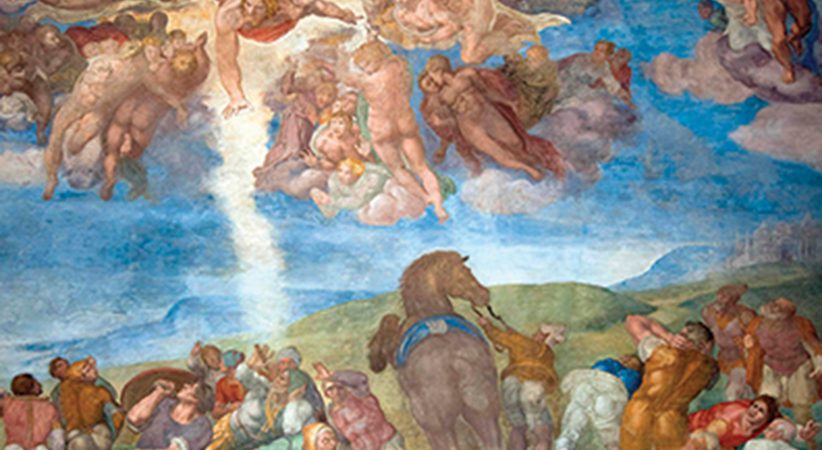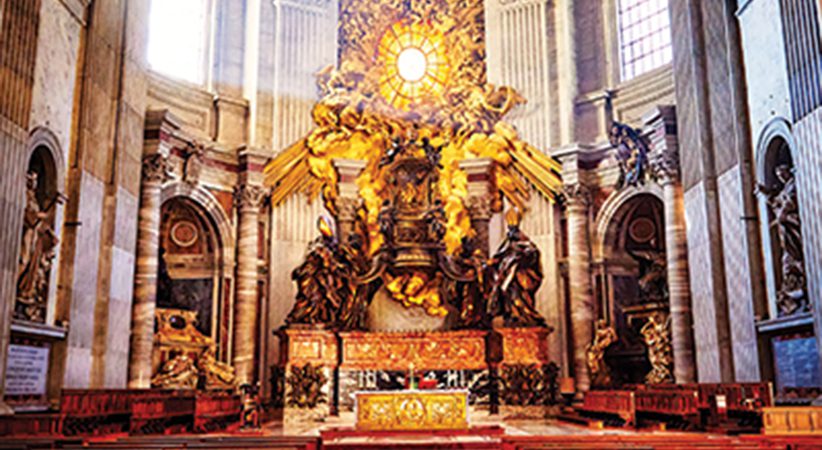A Few Reminders about Preaching
Four tips to help priests with Sunday homilies
Father Herb Weber Comments Off on A Few Reminders about Preaching
Every so often, someone will ask how long it takes me to write my Sunday homily. I am unable to answer because, by the time the weekend comes around, I have lived with that particular homily for most of the week, sharing thoughts with others and writing notes to myself as the homily matures.
I do actually put the words of the homily into my computer before I am fully finished in preparation. It’s not that I read the homily as such, but disciplining myself to write it out often helps with transitions, clarity of thought and appropriate use of words and images.
Every priest has heard much about preaching. Some accept the weekly challenge with great joy in knowing a sacred duty is entrusted to them. Others, including those who do well, are often overwhelmed to know they are expected to deliver quality again and again.
In addition, I acknowledge that most pastors are also expected to provide homilies throughout the week for weekday Masses, funerals, weddings and reconciliation services. I can recall working on three to five different homilies to be delivered within two or three days!
Rather than being a treatise on preaching, this article simply wants to share four reminders that will help each priest in the ministry of preaching the Sunday homily.
Step One: Invest Sufficient Time
In an age of fast preparations for food, K-Cups for coffee, and next-day delivery of packages, it is easy to assume that homilies can be created during an hour set aside on Friday afternoon. That notion fails to understand how a homily needs to be shaped over time.
Two days before Christmas, a priest said to me that he was planning to use the next day to “pull together” something for his Christmas homily. I prayed he was joking, but I also feared he was being serious, hoping to be inspired at that last minute.
It can be debated what is the most important ministry a priest includes in his weekly schedule, but there is probably no other task that demands as much creativity and personal input from the priest, nor has the potential of reaching as many people, as the weekly Sunday homily. To say that it requires time and energy is an understatement.
Over the years I have come to know the liturgical cycle rather well, but I still look ahead two or three weeks just to know what Gospel passages are coming up. That is the remote preparation that allows me to see more fully the way the Gospel is opening itself up through our liturgical cycle. I still cringe to think about the first time I approached Chapter 6 of John’s Gospel in Lectionary Year B, discovering after the first Sunday of expounding on the Bread of Life, that there were still four more Sundays to go!
Instead of simply sitting down to write a homily, it may be much better to let the readings of the upcoming Sunday percolate in the preacher’s mind and heart — that is, the homilist needs to live with the Scriptures of the Sunday, particularly the Gospel reading. This may include reading them with friends, doing some study in commentaries and discussing the passage’s impact on people’s lives.
For many years I have been fortunate enough to be part of a Tuesday morning Bible study group that would read the upcoming Sunday’s readings. The make-up of these lay groups has varied through the years and that, too, has been good as I realize the way certain passages speak to people with differing backgrounds. In addition, I have regularly listened to a discussion on the very same Gospel passage at weekly RCIA sessions. And then again, the weekly staff meetings have allowed a third weekly review of the readings. Instead of overdoing it, these multiple readings have allowed me to hear the passage with new interest and insight.
Then comes the time for reflection. While driving, when taking a walk in the park, or while doodling with a yellow tablet, I often jot down ideas and phrases that flow from these reflections. I always have a notebook with me in order to write my thoughts. There have been times when I have stopped my car in a parking lot to scribble down some words, so as not to forget important ideas that have come to me while driving.
Through all this, I continue to ask what this particular reading is saying to us today. Certainly, I want to be true to its meaning from the first century, but I also need to address the way it is speaking to us in the 21st century.
All of this takes time, and so far, I have only been describing the early steps in putting together a homily. The rest comes later in the week.
By this point, I suspect that readers may be wondering how a pastor of a large and busy parish can find time to do all this every week. The answer is that it is possible when the homily is given high priority.
Step Two: Listen and Listen Again
Preachers think that homilies are about speaking — and that is true — but they are also about listening. Priests need to listen to what people are struggling with, like raising families, facing daily struggles and worrying about the future. Homilies also need to tune in to current affairs, especially those issues that have strong faith implications like immigration or violence, not to mention reverence for human life. Priests need to be aware of what is going on in the cultural world in which Sunday’s listeners live.
This does not mean that the homilist has to drop the names of every celebrity interviewed on “Entertainment Tonight,” but an awareness of what is happening in music, theater, sports or the arts can help the preacher discover where the minds of parishioners may be.
I would add to this that a good homilist has to be a reader. He has to have a love for words and enjoy how those words can convey a message, whether in poetry, storytelling or high drama. This can allow the speaker to weave together phrases in masterful ways.
Although a spoken medium, basic rules for writing need to be followed. Good grammar does matter. More importantly, the guidelines for composition also apply, like having an introduction, a main body of material and a conclusion. One music director, who, because of his position, hears lots of homilies, often talks about those preachers who can’t “land the plane.” That is his way of saying some homilists haven’t remembered to structure their homilies with a beginning, a middle and an end.
Finally, and certainly not least, the homilist must listen to the Holy Spirit. Sadly, I have known speakers who simply think that the Holy Spirit will pull the right words out of them in a way to inspire people. The Holy Spirit does, in fact, use our words to touch hearts. But that is not done in place of preparation and hard work.
Step Three: Clarify What You Are Saying
Trying to find a phrase that sums up the homily is more than just a trick that I have employed. It often is the compass that allows me to find and stay directed to the true north in my preaching. Simply put, as the week progresses and I know the point of the homily, then I write down a phrase that sums up my message. Sometimes, it is a catchphrase or a primary point that people can take home with them. Other times, it is simply a way for me not to wander astray.
There is no need to say everything that one knows about any scriptural pericope. Furthermore, doing the exegesis as part of the homily should be used only rarely. Usually, the background work is just that, background work. Retelling the Gospel account has to be questioned for its inclusion in the homily. A man told me that his pastor spends six minutes retelling the Gospel, and then spends the final three minutes making a point. The man was offended because he felt it unnecessary to hear again what was already proclaimed. He was hungry for those last three minutes to be extended.
If a Sunday homily is laser-focused, that allows something else to take place. Within the concise statement of a premise that the homilist has provided, he now has room to truly open up the message. If the message is how the light of the Lord is shared with his disciples, who need to bring light into a dark world, then the preacher does well to address both contemporary darkness and the way that light can shine. Images abound, and those right-brain illustrations can help people of many backgrounds connect.
Toward the end of each week, I take time to write out a detailed outline of what is to be the homily. I have filled many yellow tablets over the years, often writing in bullet-point form. The incorporation of observations or other images that help relate the message is included here. Such images may include stories, but I shy away from the homily-help variety of stories that so pervade homilies. Mostly, I use observations that I have discovered as I continue to examine faith in the contemporary world.
Step Four: Don’t Skip the Final Steps
I recall going to a speech that was being delivered by a well-known Catholic author. He started by admitting that he was venturing into a new area of thought. When he was finished, I felt that I had just listened to something other than the final draft. His ideas showed promise but hung together badly. What’s more, he never was able to truly define where he was headed.
Sometimes, the homilies we deliver tend to be like the brownies that come out of the oven too soon. At first, they appear good and may even smell great, but once we bite into them, we discover they are not finished. The task of completing the homily is what I find hardest and takes the most self-discipline.
As I indicated, I don’t read my homily. Nevertheless, I have found writing out a final draft to be a necessary practice. Amazingly, almost every week, some of what I had considered to be my best points or examples end up on the cutting-room floor because they don’t really help make the intended point.
Even as a homily is put into the computer, it is necessary to remember that the end product is something to be heard and not read by those in attendance. What may seem to be a good essay may not present itself well when spoken aloud.
As for the ongoing debate between those who read a homily and those who do not, I know that some people do well to rely on what is in print before them. They should be cautioned, however, to know that having that sheet of paper and looking down on a regular basis can become a barrier between the speaker and those who are listening. I often hear from people that they appreciate it when the homilist is conversing directly with them.
Finally, I practice my homily a number of times before it is ready to be delivered. If a story or illustration is involved, I am certain to share that with others, so that I can find the best and clearest way to frame what I am saying. This step could be misleading, however, if I were only to share with admirers who are hesitant to give honest and direct feedback.
Preaching every week can be an incredible form of evangelizing. It has the potential to help people discover the ongoing relevance of the Scriptures. That it takes both time and work is not really too much to invest for powerful returns.
FATHER HERB WEBER is a retired priest from the Diocese of Toledo. He was ordained in 1974.
……………………………………………………………………………………………………………………………………………
Pope Francis’ Method of Homily Preparation
In Evangelii Gaudium (“The Joy of the Gospel”), Pope Francis writes about the preparation to preach: “Preparation for preaching is so important a task that a prolonged time of study, prayer, reflection and pastoral creativity should be devoted to it. With great affection I wish to stop for a moment and offer a method of preparing homilies” (No. 145).
The first step: “After calling upon the Holy Spirit in prayer, is to give our entire attention to the biblical text, which needs to be the basis of our preaching” (No. 147).
“The preacher ‘ought first of all to develop a great personal familiarity with the word of God. Knowledge of its linguistic or exegetical aspects, though certainly necessary, is not enough. He needs to approach the word with a docile and prayerful heart so that it may deeply penetrate his thoughts and feelings and bring about a new outlook in him’” (No. 149).
He adds: “There is one particular way of listening to what the Lord wishes to tell us in his word and of letting ourselves be transformed by the Spirit. It is what we call lectio divina. It consists of reading God’s word in a moment of prayer and allowing it to enlighten and renew us” (No. 152).
Pope Francis also says: “The preacher also needs to keep his ear to the people and to discover what it is that the faithful need to hear. A preacher has to contemplate the word, but he also has to contemplate his people” (No. 154).
In regards to homiletic resources, the pope writes: “Simply using a few examples, let us recall some practical resources which can enrich our preaching and make it more attractive. One of the most important things is to learn how to use images in preaching, how to appeal to imagery” (No. 157).
He also speaks of simplicity: “Simplicity has to do with the language we use. It must be one that people understand, lest we risk speaking to a void. Preachers often use words learned during their studies and in specialized settings which are not part of the ordinary language of their hearers” (No. 158).
He adds: “Another feature of a good homily is that it is positive. It is not so much concerned with pointing out what shouldn’t be done, but with suggesting what we can do better” (No. 159).
………………………………………………………………………………………………………………………………………………..





